How the Fujifilm X-H Line SAVED the Fujifilm X-T5
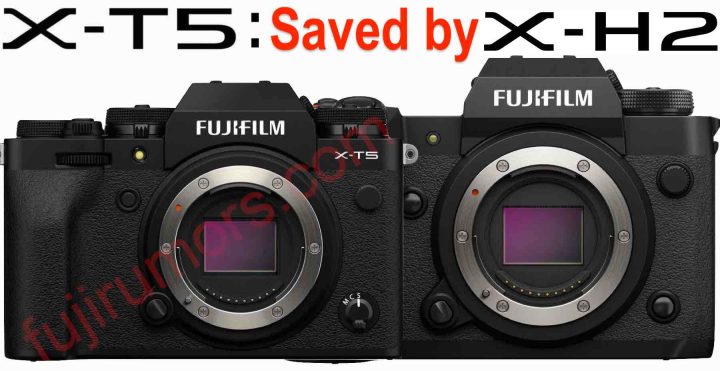
The Fujifilm X-T line was never ment to be a flagship.
And how do I know?
Well, I tell you now…

The Fujifilm X-T line was never ment to be a flagship.
And how do I know?
Well, I tell you now…
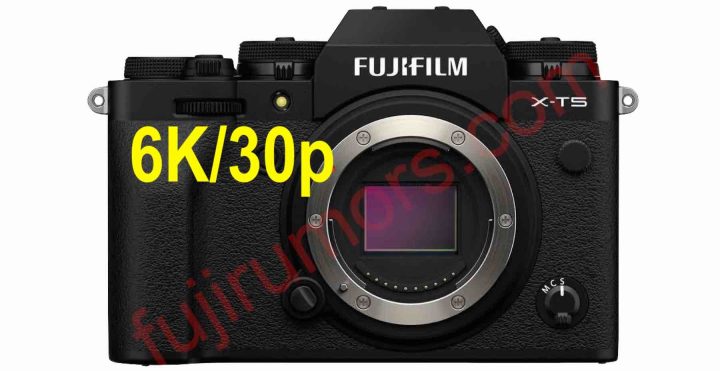
When I told you that the Fujifilm X-T5 will be smaller than the Fujifilm X-T4, some of you understood that this might be the reason why it won’t shoot 8K video (smaller bodies struggle more with heat management than bigger bodies).
But others were worried that the Fujifilm X-T5 won’t even offer 6K video.
So I am glad to report that, despite getting smaller, the Fujifilm X-T5 will still be able to shoot 6K video, more precisely 6K/30p.
So yes, it is not 8K, but 6K should be a pretty decent format for most video uses anyway.
The X-T5 is still a very nice hybrid camera.
Fujifilm X-T5 rumors recap:
Follow FujiRumors on Facebook, Instagram, RSS-feed, Youtube, Flipboard and Twitter.
100% Fuji Colors Power
Rumors and Discussions
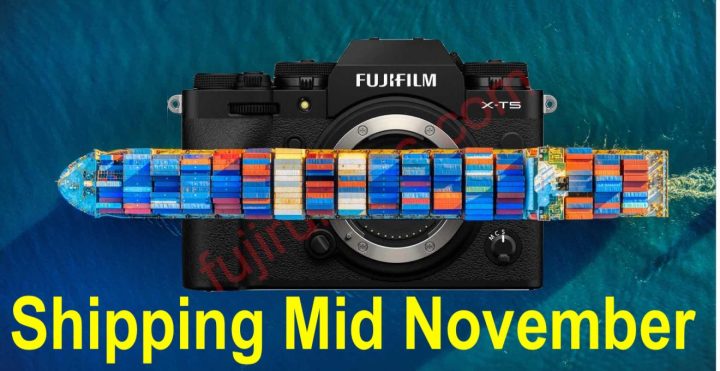
Fujifilm seems to be in a hurry with the Fujifilm X-T5.
We told you Fujifilm will announce the Fujifilm X-T5 (and XF30mmF2.8 Macro) on November 2 and in fact it is now official as the Fujifilm X summit has been annouced. That’s per se surprising, as they never launched camera gear in November.
But it gets even better.
Fujifilm will start shipping the Fujifilm X-T5 already in mid November, which means just about 2 weeks after its announcement. I can’t remember Fujifilm ever start to ship gear as fast.
Fujifilm X-T5 rumors recap:
![]()
I have read speculation about Fujifilm not offering pixel shift on the Fujifilm X-T5 in order to differentiate it even further from the Fujifilm X-H2 and keep pushing sales of their higher end X-H line.
So I investigated and our sources would like to reassure us future X-T5 owners that these speculations are not accurate.
The Fujifilm X-T5 will offer pixel shift, hence it will have the capability to take 160 megapixel images. And of course this means also that the X-T5 has sensor shift stabilization (IBIS), which is needed for pixel shift.
Fujifilm X-T5 rumors recap:
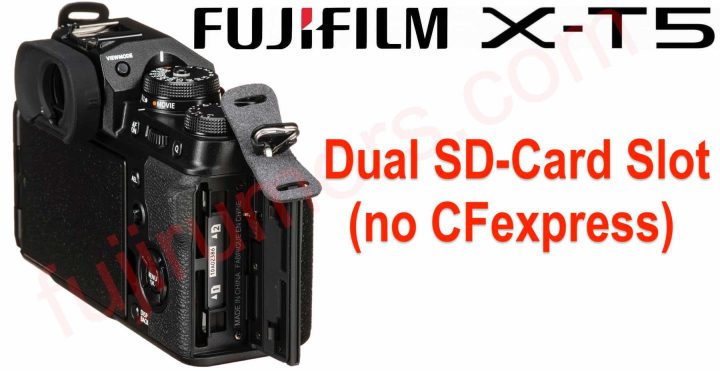
I must say that I am a bit relieved to hear (and share) this rumor, because it is going to save me hundreds of dollars ;)
The Fujifilm X-T5 will have dual SD-card slots (no CFexpress compatibility).
For my type of shooting (no crazy ultra high fps bursts), UHS-II SD-Cards are fast enough to have a smooth and pleasing shooting experience.
So when I get my Fujifilm X-T5, I won’t have to spend more money into CFexpress cards. I just use the plenty of SD-Cards I already have at home.
But I am curious to hear what you guys think about it. Maybe for some of you this is a dealbreaker?
Fujifilm X-T5 rumors recap:
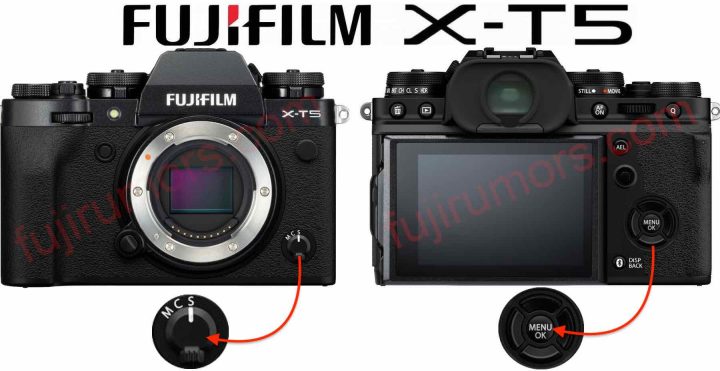
Yesterday I leaked the mock-ups of the Fujifilm X-T5, which you can see here.
You can notice that the mock-ups show a D-Pad and a dedicated manual MCS switch (as opposed to the X-H2/S, which have an FN button there)
Since I never specifically rumored the D-Pad and MCS switch, quite often the question came up in the comments asking me if this means that MCS and D-pad are confirmed. So let me answer this very clearly in a dedicated article: yes, the Fujifilm X-T5 will have a manual MCS switch and a D-Pad.
Fujifilm X-T5 rumors recap:
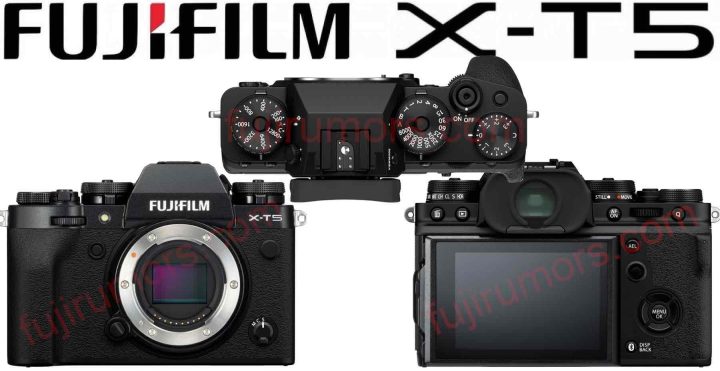
Ok guys, so how does the Fujifilm X-T5 look like?
Well, according to our sources you could basically imagine it as a smaller X-T4 with the 3 way tilt screen of the Fujifilm X-T3.
But there are some minor details that we will try to illustrate with some renderings we made below.
And to be clear: what you see below is NOT the real Fujifilm X-T5, but the final thing will be very close to what you see here. The only difference between these mock-ups and the real Fujifilm X-T5 will be that the size of the X-T5 (for example the real X-T5 is a bit narrower) and the grip is slightly different. The mock-ups use the grip of the X-T4 because that grip is closer to the real X-T5 than the grip of any other X-T camera.
Overall, let’s put it down like this: these mock-ups are so close to the real Fujifilm X-T5, that when the real X-T5 leaks very soon, you will find the leaked images very boring ;).
Lets start with the front:
With every new X-T generation, the Fujifilm X-T line got bigger.
Well, according to our sources, the Fujifilm X-T5 will revert this trend as it will actually be smaller than the Fujifilm X-T4.
What would your ideal size be?
You can click the image above to enlarge it, compare the various sizes and then feel free to vote the survey down below.
Fujifilm X-T5 rumors recap:
Follow FujiRumors on Facebook, Instagram, RSS-feed, Youtube, Flipboard and Twitter.
100% Fuji Colors Power
Rumors and Discussions
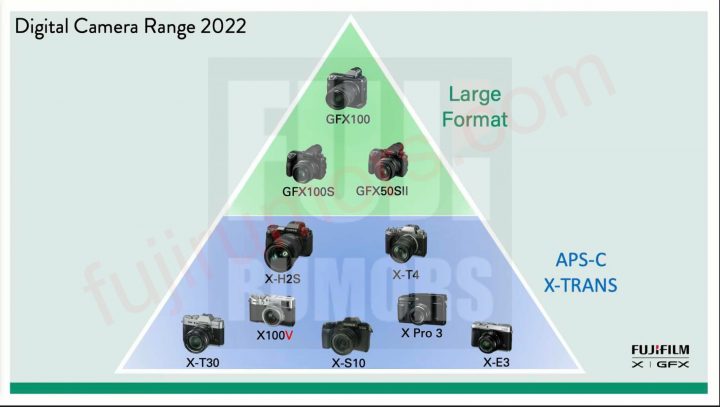
THIS IS NOT A RUMOR and NOTHING FUJIFILM HAS OFFICIALLY ANNOUNCED
All the below are my thoughts, guesses and speculations based on an slide Fujifilm showed and on hints dropped in past Fujifilm statements.
At no point Fujifilm said that both lines are 100% axed. And a slide shown by a regional outlet of Fujifilm has less value than what the official Fujifilm headquarter in Japan says.
None… I repeat, NONE of my sources has told me the Fujifilm GFX50R or X70 won’t get a successor.
You might remember how a few months ago, Fuji Guy Billy explained the digital camera range of Fujifilm.
The list Billy made gave us indication on which lines are very likely to see a successor and which ones not.
However, in the list Billy did GFX cameras and fixed lens cameras were not included.
And this brings us to today’s article.
I have received the slide you can see above that Fujifilm used during a press meeting.
Just like with Billy’s list, also here we see no entry level X series camera anymore.
In addition to that, this slide contains the Fujifilm X100V, which means it’s a solid part of the family and will get a successor at some point.
The new Fujifilm X-H2 is missing, but only because the slide was shown to press before the launch of the Fujifilm X-H2.
Totally missing though are the Fujifilm X70/XF10 and the Fujifilm GFX50R.
So what does this mean?
Well, the fact that neither the GFX50R nor the X70 are in the list certainly shows that those cameras do not play an important role in Fuji’s lineup anymore.
Regarding the Fujiifilm GFX50R, Fujifilm managers made some conflicting statements: the first one said that they see no need for a GFX50R successor due to the reasons we explained here, and the second manager clearly expressed his wish for this line to continue. So I guess not even in Japan the final word on the GFX50R successor has yet been spoken.
As far as the Fujifilm X70 goes, Fujifilm should not blame the camera for its failure. It was destined to fail due to horrible (can I say “stupid”?) decisions Fujifilm made and that we explained in this article. And to make things worst, they tried to fix it with the Fujifilm XF10, which is just another error in planing. I believe this could be a very successful line… if Fujifilm finally decides to treat it with dignity!
But sure, in times where camera companies struggle, I would not be totally surprised if those cameras, that are not vital for the system, get dropped. It would save R&D to focus on other more popular models.
Also, APS-C is marked as “X-Trans”, so this might indicate that there is no space anymore for Bayer in the APS-C lineup (which so far was reserved for lower end models).
Follow FujiRumors on Facebook, Instagram, RSS-feed, Youtube, Flipboard and Twitter.
100% Fuji Colors Power
Rumors and Discussions

When I asked what you’d like to know about the Fujifilm X-T5, there were quite some guys asking me if it would come in black and silver (many of you asked me also privately via email or social media).
And I can see why you ask me this.
Fujifilm is offering the Fujifilm X-H2 and X-H2S in black, when they launched the Fujifilm X-T3WW it also came just in black, and even the X-T4 silver started to get discontinued.
It all looked like Fujifilm was giving up on the silver color.
But not with the Fujifilm X-T5.
If you like your X-T camera in silver, then, according to our sources, you can rest assured that the Fujifilm X-T5 will be offered in black and silver.
Now feel free to let us know in the survey down below which color you prefer.
Personally, I owned black as well as silver X-T cameras. I’d be happy with either color. Maybe the silver color gives a bit more of a vintage touch, but the all black version looks so sexy too. I guess I am one of those who’d be happy with both cameras, and I will struggle until the last minute before I place my X-T5 pre-order.
Fujifilm X-T5 rumors recap:
Follow FujiRumors on Facebook, Instagram, RSS-feed, Youtube, Flipboard and Twitter.
100% Fuji Colors Power
Rumors and Discussions